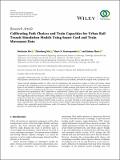Calibrating Path Choices and Train Capacities for Urban Rail Transit Simulation Models Using Smart Card and Train Movement Data
Author(s)
Mo, B; Ma, Z; Koutsopoulos, HN; Zhao, J
DownloadPublished version (2.012Mb)
Publisher with Creative Commons License
Publisher with Creative Commons License
Creative Commons Attribution
Terms of use
Metadata
Show full item recordAbstract
© 2021 Baichuan Mo et al. Transit network simulation models are often used for performance and retrospective analysis of urban rail systems, taking advantage of the availability of extensive automated fare collection (AFC) and automated vehicle location (AVL) data. Important inputs to such models, in addition to origin-destination flows, include passenger path choices and train capacity. Train capacity, which has often been overlooked in the literature, is an important input that exhibits a lot of variabilities. The paper proposes a simulation-based optimization (SBO) framework to simultaneously calibrate path choices and train capacity for urban rail systems using AFC and AVL data. The calibration is formulated as an optimization problem with a black-box objective function. Seven algorithms from four branches of SBO solving methods are evaluated. The algorithms are evaluated using an experimental design that includes five scenarios, representing different degrees of path choice randomness and crowding sensitivity. Data from the Hong Kong Mass Transit Railway (MTR) system is used as a case study. The data is used to generate synthetic observations used as "ground truth."The results show that the response surface methods (particularly constrained optimization using response surfaces) have consistently good performance under all scenarios. The proposed approach drives large-scale simulation applications for monitoring and planning.
Date issued
2021-01-01Department
Massachusetts Institute of Technology. Department of Civil and Environmental Engineering; Massachusetts Institute of Technology. Department of Urban Studies and PlanningJournal
Journal of Advanced Transportation
Publisher
Hindawi Limited